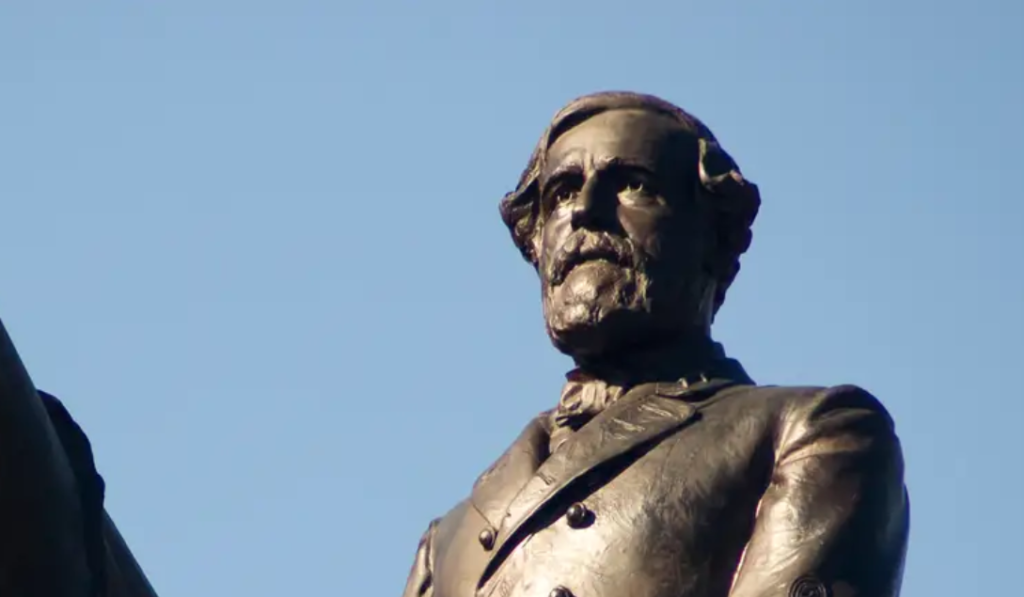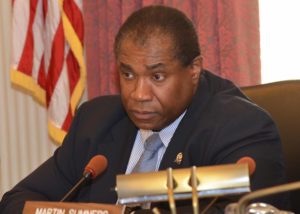To Lee or not to Lee, that is the Question

Men who tried, expending their money and often their blood, to leave the union of states they broke faith with, stand in the same federal district as figures like President U.S. Grant. The equestrian statue of the Union’s great commander, and later president, stands watch in front of the US Capitol building. Unlike Napoleon, whose tactics he studied, and unlike Caesar, whose glory he did not seek, Henry Shrady’s sculptural masterpiece of Grant surveys the Mall, dominated by the Washington Monument, showing the man in a simple overcoat and topped by a humble broad-brimmed hat. He demonstrates calm, unflappable leadership: the captain of the cause amidst the storm of war. Around him are scenes of violence and slaughter, dynamic visualizations of the strength, terror, and valor which was exhibited by the men who fought, starved, froze, sweltered, bled, cried, and died to keep the young republic together and ensure the liberation of the slaves. Their place of honor is unquestionable. The Republican soldier-president, like Eisenhower almost a century later, proved his fidelity to America beyond question among the mortal shrieks of their country’s most sanguine contests.
Grant, whose service—albeit bloody and at times crude—in the American Civil War, helped speed the end of that conflict and took General Robert E. Lee’s surrender, but not his sword, at Appomattox 155 years ago. Today, few people give the man who graces the fifty-dollar bill much thought, overshadowed by his former commander-in-chief, assassinated at the twilight of America’s darkest hour. Nevertheless, whether on Americans’ currency or standing sentry outside the capitol, President Grant’s honor and service is rightfully preserved.
President Grant died of throat cancer in 1882 so we cannot know his thoughts about a former enemy’s likeness being installed in Washington DC some years later. The Albert Pike Memorial, the only Confederate officer to have had a monument in Washington DC, was destroyed during George Floyd protests this year. The statue was pulled down from its plinth and set on fire. When the statue was constructed in 1898, however, Union Army veterans, part of the Grand Army of the Republic veterans’ organization, decried the decision to install it, but their complaints were for naught.
A decade prior in 1886, a monument had been erected to the Confederate-aligned First Maryland Battalion, later renamed the Second Maryland Infantry Regiment on the Gettysburg battlefield. Referring to the fact that the Confederates could “retain our swords” some twenty-one years prior, one of the regiment’s former officers asserted that the monument would allow the former Confederates to “show that we have power, and power always compels respect.”
Some members of the Gettysburg Battlefield Memorial Association voiced their discontent immediately. Three years later, the Grand Army of the Republic condemned the monument’s installation. A veteran said that Pennsylvania should have removed the “monument to treason” from the battlefield, and have it sent back to those who put it there. The GAR wrote to the Pittsburg Dispatch and their resolution was published on October 22, 1889. The resolution called the rebel monument “offensive.” The soldiers said the following:
“Whereas, the survivors of the Second Maryland Rebel regiment have erected on the battlefield of Gettysburg, within four feet of the monument erected by a loyal Maryland regiment, a monument commemorating the disloyal deeds of the said rebel regiment;
“Whereas, there is every indication that other rebel organizations and regiments will, if permitted, follow the example and thus understand to make treason honorable; therefore be it resolved, that Abe Patterson Post No. 88, Department of Pennsylvania, GAR, composed of men who gave their best service in defense of the flag, and many of whom shed their blood on the battlefield of Gettysburg, desire to enter their solemn protest against this sacrilege and most emphatically denounce any such intrusion by traitors upon sacred soil; and ask that the Gettysburg Battlefield Association, the Chairman of which is our worthy Governor of this Commonwealth, cause the said rebel monument to be removed and express orders given that no more of that nature be erected.”
In other words, the men who fought the Confederacy made it absolutely clear that they opposed monuments to the Confederate States of America and the soldiers who fought for her separatist cause. That was their statement.
With all that history in mind, the New Jersey Assembly Appropriations Committee met Monday via video conference to discuss and vote on a number of bills and a resolution, introduced by Assemblyman William Moen, AR178 entitled “An Assembly Resolution urging the United States Congress to pass legislation requiring the removal of Confederate statues in the United States Capitol building.”
The resolution targets the eleven statues of Confederates on display in the National Statuary Hall Collection, where each state can send two statues to represent them. New Jersey is represented by Richard Stockton, a signer of the Declaration of Independence, and Brigadier General Philip Kearny, who lost his life in the Civil War fighting for the Union at the Battle of Chantilly, Virginia, in 1862.

Moen’s resolution said that House Resolution 7217 seeks the Confederate statues to be either sent to the Smithsonian Institution or returned to their parent states. It stated that, “Those who committed treason against the United States, and led the nation into its most painful and bloody war to preserve the institution of slavery, are not patriots and should not be afforded the honor of having their images on display in the United States Capitol.”
The language undoubtedly echoes the words of the Pennsylvanian Union veterans, speaking through the Grand Army of the Republic, over five generations ago.
Moen said, “The monuments we keep within the United States Capitol are meant to reflect the ideals and achievement of our nation throughout its history; they are not value-neutral objects intended merely to ‘preserve history.’ And characterizing statues as the only way to preserve history diminishes their meaning and the way of memorializing significant events and figures. The monuments honoring the Confederacy have no place in the capitol building or anywhere else in our society.”
In a statement, Moen added, “The Confederate agenda has always been antithetical to our highest ideals as Americans, and to commemorate those responsible is a betrayal to our patriotism. The history of the Confederacy should be written in textbooks, not celebrated in the halls of the Capitol.”
Moen said he was “happy to report” that the House of Representatives had passed their resolution 305-113 in a bipartisan vote, and said that he, too, hoped to see such support in the committee and on the Assembly floor Thursday.
If Moen was expecting a unanimous vote, however, he was mistaken.
Assemblyman Brian Bergen, himself a US Army veteran, thanked Moen, saying that he always does great

work and appreciates what he does. “This one is difficult for me. I don’t love the idea of resolutions that tell the federal government what to do. It’s not something that I typically think is something that we should be doing. And I also don’t like rounding everybody up into one general label and putting something out like this. If we had issues with any specific statue that is in the capitol, I would have much preferred if we listed them by name, and said exactly what the objections were about that individual person. I think that would’ve been a better approach. Just to blanketly label anybody involved in the Confederacy at all as a person not worthy of a state putting them up in the capitol, I think it’s a little broad for me and I don’t like it for that particular reason so for those reasons today, and because I have a personal and moral objection to abstention, I will have to vote no, but thank you very much.”
Bergen was the only individual to vote in opposition, but took the moment to state why he felt he had to vote the way he did. His statements were cordial and seemingly sincere. Antwan McClellan, Kevin Rooney, and Jay Webber—all members of the party of Lincoln—abstained without comment.
While Assemblyman Bergen may appreciate history for its own sake, he runs against rocky ground philosophically and politically. It is also doubtful that he would have had any political loss voting in favor of Moen’s resolution, which speaks to a likely genuine sentiment.
Bergen’s grounds that the New Jersey Assembly may not have the proper standing to tell the federal government what should be done is a philosophically valid opinion, albeit one with which Chairman Burzichelli disagreed, saying, “It is always appropriate for the New Jersey legislature to express itself in the form of a resolution to our colleagues in Washington when the body so feels that it is something warranted.”
From a nuts and bolts angle, the House bill had bipartisan support, and Moen’s resolution could have been a unanimous vote—walking political easy street—unless there was sincerity in its opposition. The former enemy statesmen in question, those who Bergen wanted to specifically identify the issues held by the Assembly resolution, had substantially obvious designs against the United States. That was, in fact, the purpose of establishing the Confederacy in the first place. If that is insufficient grounds to satisfy their exclusion from the nation’s capitol, then members of the British consulate may be interested in petitioning for a monument to Major-General Robert Ross and Admiral Sir John Cochrane. They burned Washington DC to the ground, including the White House, in 1814 during America’s second war with Great Britain. These very capable officers successfully executed what the Confederacy could never achieve a half-century later.
Nevertheless, if Assemblyman Bergen feels simply being a Confederate was “a little broad” and thus not sufficient grounds to be excluded from the capitol, it is necessary to keep some fundamental facts in perspective. The Confederate States of America was the failed secessionist movement at the expense of the United States of America. Politically and militarily, it was stillborn: the product of four years of bloody warfare against the United States of America. It sought, in a futile attempt, to preserve the economically-dying and morally-isolated institution of slavery within a new political arrangement at the cost of the United States.
If that is not sufficient to deny them a place of honor in their former enemy’s capitol, the Union veterans of the GAR who actually fought those battles, having stared down southern bayonets and shrapnel rounds, certainly expressed their sentiments to that regard in the last quarter of the nineteenth century. Are the northern legislators of 2020 in a moral position to dispute their ancestors’ indignation?

Assemblyman Herb Conaway said, “I object to all Confederate statues on the nation’s capital grounds. I think it continues to send a rather dark message to the public that would elevate such characters on high. I think it is wrong and I’m glad Mr. Moen is carrying the torch for this and hopefully others will overwhelmingly agree with his approach. I vote yes.”
“Mr. Chairman, I understand that this is a difficult subject for many people and I have to admit I’m not sure why,” Vice Chairman Gary Schaer said. “This was a civil war, whether or not states could break away from the union and impose ideals which are contrary to so many things that are basic to America and its freedoms. My compliments to the chairman and Mr. Moen for his posting the bill. I understand the difficulty, I think, but we also need to understand the revulsion that other groups would have, that other peoples would have, if similar statues praising such actions were made allowed to stand. Statues to Stalin, to Lenin, and to the butchers in so many countries and so many areas, I gleefully vote in favor of this bill, Mr. Chairman.”

“I would like to associate myself with comments made by Chairman Conaway and Vice Chairman Schaer,” Chairman John Burzichelli said. “It seems odd that we would have statues of individuals who were leading a revolution so that that capitol itself would not be there, had they been successful. Clearly, the Civil War needs to be studied and learned from and those individuals who were responsible for that revolution and the deaths of so many should be studied in different ways and their remembrance should be in different places. But it is odd that it should be in our capitol, the very capitol that they thought should not exist, and should be in Virginia, and not in Washington DC.”
It is a seemingly unique American characteristic that, while the war fought 155 years ago was ended, the matter was never decisively settled. As such, Robert E. Lee’s sword, retained by the defeated general at Appomatox, still trembles in its scabbard from far beyond the grave and sends waves through American life in the 21st Century.










Leave a Reply